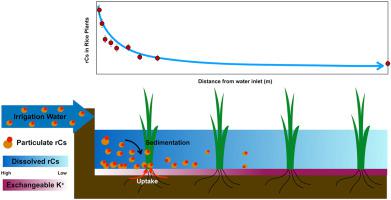Journal of Environmental Radioactivity ( IF 2.3 ) Pub Date : 2020-10-13 , DOI: 10.1016/j.jenvrad.2020.106441 Natsuki Yoshikawa , Kosei Nakashima , Yoshimasa Suzuki , Susumu Miyazu , Kazuki Suzuki , Norio Nogawa , Naoki Harada

|
To identify the cause of the phenomenon that rice plants close to the water inlet contain relatively higher radiocesium within a paddy field plot, we conducted a field experiment by establishing experimental channel using polypropylene corrugated sheets, and sampling surface water, paddy soil and rice plants according to the distance from the water inlet in 2014 and 2015. It was found that the 137Cs activity concentrations in both dissolved and particulate forms in paddy surface water presented a declining trend from the water inlet towards the outlet. The 137Cs activity concentration in paddy soil in the harvesting season and those of brown rice and rice straws were highest at 1–2 m from the water inlet. Balance calculation suggests that destination of the lost 137Cs from the surface water was likely to be adsorption of the dissolved form and sedimentation of particulate form onto the soil. The concentration of exchangeable potassium ion in paddy soil was below the recommended standard of 250 mg kg−1 (as K2O in dry soil) near the water inlet at the harvesting period both years.These findings suggested that the possible crucial factors to induce rice plant uptake of radiocesium near the water inlet were either (1) direct absorption of dissolved 137Cs in surface water by rice plants, (2) absorption of 137Cs, which was originally retained in particulate matter and released by ion exchange and/or by organic matter decomposition in combination with (3) loss of soil exchangeable potassium caused due partly to transportation of soil particles with exchangeable potassium by the rapid water flow near the water inlet and/or leaching by ion exchange onto the soil of other cations such as calcium ion flowing into the paddy field. These findings will contribute to providing possible measures for producing safe rice in highly contaminated areas in which agricultural production will resume in the near future. We propose providing a non-planting zone for the area closer than about 5 m from the water intake to avoid the occurrence of high 137Cs concentrations in rice crops.
中文翻译:

灌溉水的摄入量对进水口附近水稻植株放射性铯活性浓度局部增加的影响
为了找出导致稻田附近进水口的水稻植株中放射性铯含量较高的现象的原因,我们进行了田间试验,方法是使用聚丙烯波纹板建立实验通道,并根据地表水,稻田土壤和水稻植株取样到2014年和2015年距进水口的距离。发现稻田地表水中溶解和颗粒形式的137 Cs活性浓度呈现出从进水口到出水口的下降趋势。在137在收获季节水稻土和那些糙米和稻草的活性铯浓度为最高,从进水口1-2米。余额计算表明丢失的目的地137来自地表水的Cs可能是溶解形式的吸附和微粒形式在土壤上的沉淀。在两年的收获期附近,稻田土壤中可交换钾离子的浓度均低于进水口附近推荐的250 mg kg -1(作为干燥土壤中的K 2 O)的推荐标准。附近的水入口放射性铯的水稻植物摄取分别为:(1)溶解的直接吸收137个的表面中通过水稻植物CS,(2)吸收137Cs最初保留在颗粒物质中,通过离子交换和/或有机物分解与(3)土壤可交换钾的流失结合而释放,部分原因是土壤中可交换钾的快速流动导致土壤中可交换钾的运移。进水和/或通过离子交换将其他阳离子(如流入水稻田的钙离子)转移到土壤中。这些发现将有助于提供可能的措施,以在不久的将来恢复农业生产的高度污染地区生产安全的水稻。我们建议在距进水口约5 m处的区域提供一个非种植区,以避免水稻作物中高137 Cs浓度的发生。



























 京公网安备 11010802027423号
京公网安备 11010802027423号